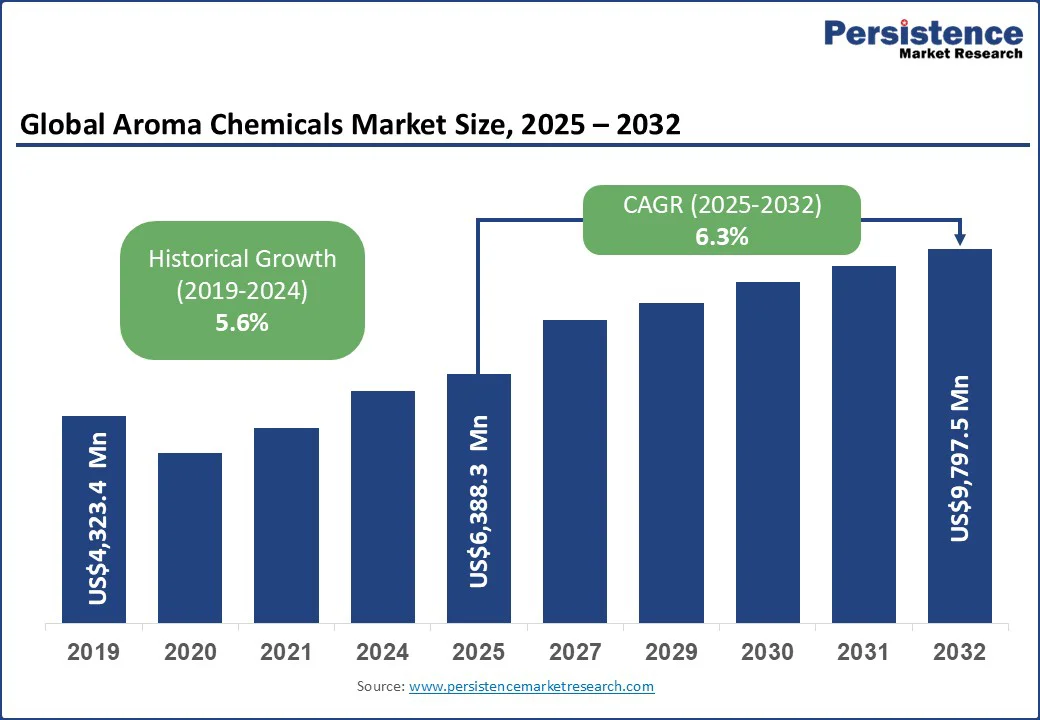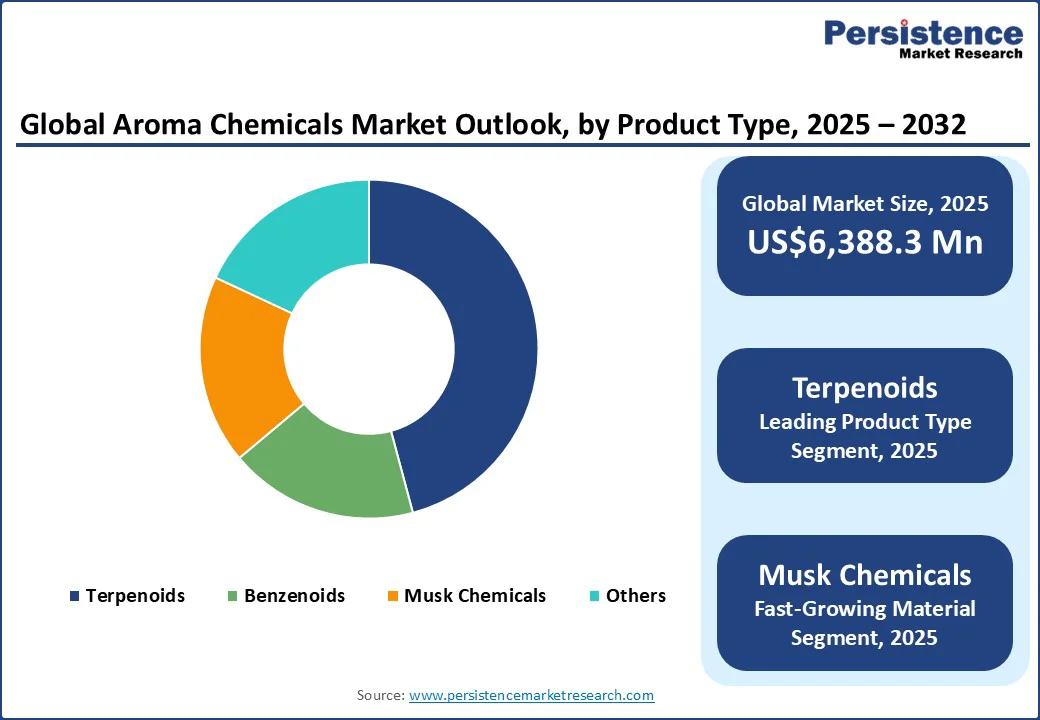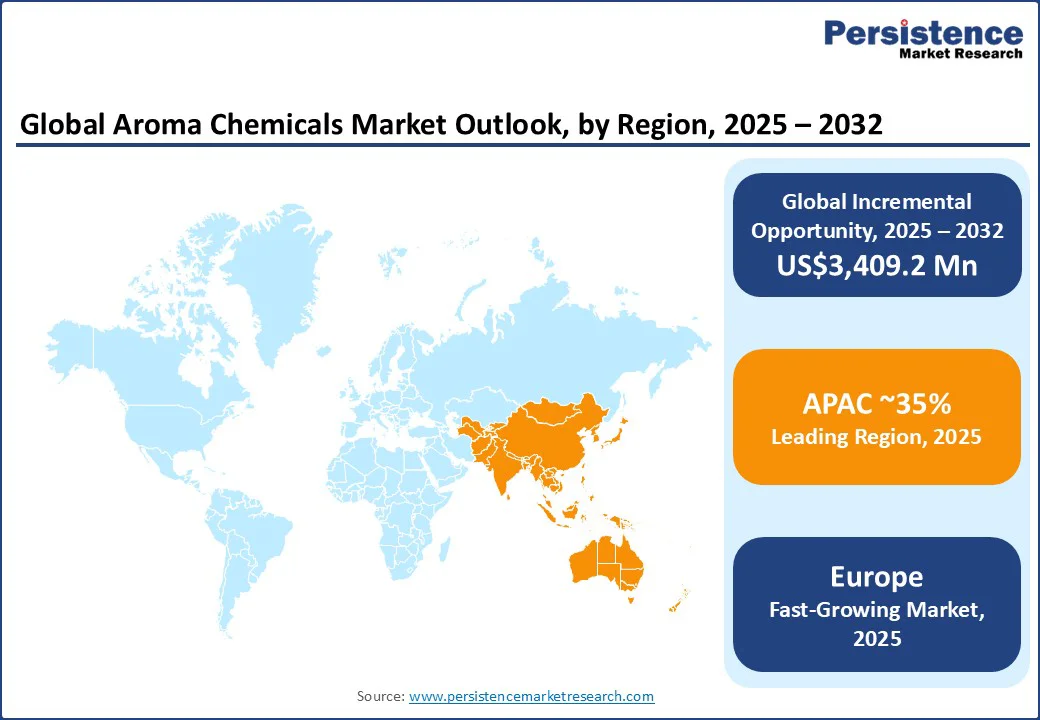ID: PMRREP15388| 180 Pages | 8 Sep 2025 | Format: PDF, Excel, PPT* | Chemicals and Materials

The global aroma chemicals market size is likely to be valued at US$6,388.3 Mn in 2025 and is expected to reach US$9,797.5 Mn by 2032, growing at a CAGR of 6.3% during the forecast period from 2025 to 2032. The aroma chemicals market has witnessed rapid growth in recent years, driven by increasing demand for natural, sustainable ingredients in the food & beverage, personal care, and home care sectors.

Key Industry Highlights:
|
Global Market Attribute |
Key Insights |
|
Aroma Chemicals Market Size (2025E) |
US$6,388.3 Mn |
|
Market Value Forecast (2032F) |
US$9,797.5 Mn |
|
Projected Growth (CAGR 2025 to 2032) |
6.3% |
|
Historical Market Growth (CAGR 2019 to 2024) |
5.6% |
The market is witnessing strong growth, driven by rising demand across cosmetics, personal care, food, and feed industries. Increasing consumer inclination toward skincare, haircare, and premium beauty products such as creams, facemasks, shampoos, lotions, and soaps is fueling the consumption of fragrance chemicals that enhance product appeal without compromising quality. Rapid urbanization, e-commerce expansion, and rising disposable incomes are accelerating the adoption of natural and organic cosmetics, creating lucrative opportunities for aroma chemical manufacturers. Major cosmetic brands are innovating with natural ingredients and bio-based fragrances to meet the growing consumer awareness of sustainability and unique scents.
The food & beverage industry is a key growth driver, with aroma compounds such as vanillin, ethylvanillin, raspberry ketone, and mint oil widely used in bakery, confectionery, ice creams, and beverages to enhance flavor and freshness. In the animal nutrition sector, feed producers rely on chemicals such as vanillin and cinnamaldehyde to improve palatability, boosting their role in livestock feed formulations.
The dual demand from cosmetics and food applications, coupled with innovations such as IFF’s AURIST™ AGC bio-based solutions and Firmenich’s sustainable fragrance sourcing, underlines the expanding scope of the market in 2025 and beyond.
Fragrances are formulated using a wide range of aroma chemicals, many of which raise concerns for both human health and environmental safety. Studies show that nearly 95% of synthetic fragrance ingredients are derived from petroleum-based compounds such as benzene derivatives, aldehydes, and phthalates, which have been linked to birth defects, cancer, hormonal disruption, diabetes, allergies, asthma, and nervous system disorders.
The Environmental Working Group (EWG) reports that approximately 75% of fragrance products contain phthalates, several of which are classified as hazardous wastes by the U.S. Environmental Protection Agency (EPA). Beyond health risks, certain synthetic chemicals are also harmful to ecosystems, making strict regulation essential.
To address these risks, the International Fragrance Association (IFRA) enforces globally recognized IFRA Standards, which are regularly updated based on scientific research. These guidelines classify fragrance chemicals into three categories: prohibited substances (musk xylene banned for its bioaccumulation dangers), restricted substances (linalool and coumarin allowed only in controlled concentrations due to allergenicity and skin sensitivity risks), and specification standards (ensuring purity in fragrance ingredients, for example, requiring citrus oils to be free of phototoxic compounds).
These regulatory restrictions, health risks, and environmental concerns act as major restraints, challenging the market while accelerating the shift toward sustainable and natural fragrance alternatives.
The aroma chemical market is primarily driven by the surging demand for natural, sustainable, and clean-label ingredients. Consumers are increasingly shifting away from synthetic formulations due to health and environmental concerns, favoring products derived from renewable and eco-friendly sources. This shift is particularly strong across cosmetics, personal care, and food & beverage industries, where premiumization and sustainability are key purchase drivers.
Manufacturers who can deliver high-quality natural aroma chemicals through ethical sourcing and advanced technologies stand to capture a significant market share. Notable innovations, such as Symrise’s Diana food™ bioactives (2023) and DSM-Firmenich’s Firgood™ collection of 100% natural extracts, demonstrate the rising importance of biotechnology, synthetic biology, and green chemistry in shaping future product lines. These advancements address consumer demand and help companies meet stringent regulatory standards for safety and sustainability.
Furthermore, emerging trends such as personalized fragrances, functional scents, and wellness-focused ingredients create additional growth avenues. Strategic R&D investments, partnerships, and infrastructure expansions will be critical for market players seeking long-term competitiveness. With strong alignment between consumer preferences, regulatory frameworks, and sustainability goals, the market offers transformative opportunities for manufacturers, suppliers, and investors worldwide.
The terpenoids segment is anticipated to lead, accounting for over 35% revenue share in 2025. Terpenoids, derived from essential oils of citrus fruits, lavender, eucalyptus, and other botanicals, are highly valued for their natural origin, aromatic complexity, and versatility across multiple applications. The rising consumer shift toward natural, clean-label, and wellness-oriented products has significantly boosted the demand for terpenoids in fine fragrances, cosmetics, and the food & beverage industry.
Moreover, the growing adoption of aromatherapy and functional fragrances further amplifies demand, as terpenoids are recognized for their therapeutic properties, such as relaxation and stress relief. Their wide fragrance spectrum, from citrus to floral, makes them indispensable in developing both natural and synthetic product formulations.
Sustainability trends and increasing consumer preference for authentic, plant-based ingredients further reinforce terpenoids’ leadership in the market. Additionally, they are extensively used as natural flavor enhancers in food and beverages, complementing their role in cosmetics and perfumes. Alongside terpenoids, musk chemicals are also projected to register substantial growth due to their rising applications in soaps, detergents, personal care products, and food items. Together, these factors position aroma chemicals as essential drivers of global fragrance and flavor innovation.
The synthetic segment is projected to dominate with approximately 67% of the revenue share in 2025, due to its cost-effectiveness, consistent quality, scalability, and the ability to meet large-scale industrial demand. Unlike natural extracts, synthetics provide stable pricing and reliable supply, making them highly attractive to manufacturers of soaps, detergents, cosmetics, and personal care products. Synthetic production also allows for precise control over chemical composition, ensuring consistent scent profiles essential for mass-market applications.
Global players such as BASF synthesize key compounds such as citral and geraniol, widely used in fragrances, flavors, and industrial products, showcasing how scalability and innovation sustain market leadership. Furthermore, advancements in synthetic chemistry allow the development of complex molecules that closely replicate natural aromas, strengthening adoption in both flavor and fragrance industries.
Growth is not without challenges; some synthetic chemicals are classified as hazardous by the U.S. Environmental Protection Agency (EPA). Research from the Environmental Working Group (EWG) shows that nearly 75% of fragrance products contain phthalates, linked to breast cancer, diabetes, reduced sperm count, reproductive issues, and hormonal disruption. Such health and regulatory concerns may impede long-term market expansion, creating opportunities for natural and sustainable aroma solutions.

Asia Pacific is anticipated to dominate globally, holding more than 35% of the revenue share in 2025. The region is projected to expand at a strong 6.1% CAGR through 2032. Growth is primarily fueled by the booming cosmetics, personal care, and food & beverage industries in China, India, Japan, and South Korea. Rising consumer spending on premium and natural fragrances, combined with the demand for customized and niche scents, is further accelerating market expansion.
China leads regional growth, with fine fragrances expected to account for approximately 50.7% of the market share in 2025. India, the fourth largest beauty market worldwide by purchase volume, is also witnessing steady growth, driven by a young consumer base and rising cosmetic demand. In terms of per capita revenue, each person in Japan is expected to generate US$405.05 in 2025, highlighting strong consumer spending power.
Major players are strengthening their presence across the region. Firmenich opened its Fine Fragrance Atelier in China to meet increasing demand, while International Flavors & Fragrances (IFF) reported global sales of US$12.44 Bn in 2022 and invested over US$603 Bn in R&D, showcasing the strategic importance of aroma chemicals.
According to the International Fragrance Association (IFRA), Asia Pacific is one of the most diverse and dynamic fragrance regions globally, where fragrance plays a vital role in culture, economy, and daily life. From sandalwood in Australia and vetiver in Indonesia to jasmine in India and tea extracts in China, the region is home to the world’s most treasured fragrance ingredients. As demand rises, Asia Pacific is also emerging as a hub for innovation, sustainable practices, and responsible regulation, cementing its position as the fastest-growing market for aroma chemicals.
North America is anticipated to remain a key growth hub, driven by advanced R&D infrastructure, a strong presence of global fragrance and flavor leaders, and high consumer demand for premium personal care and cosmetic products. In 2025, North America accounted for more than 24% of the market share, fueled by mature sectors such as fine fragrances, cosmetics, and packaged foods. Strong regulations and biotech investments in sustainable aroma synthesis position the region as a global innovation leader. With its premium consumer base, strong economic drivers, and focus on sustainability, North America continues to lead the market. The U.S. dominates the regional market, led by major players such as IFF (International Flavors & Fragrances) and Firmenich, alongside strong consumption from the cosmetics, home care, and food & beverage industries.
The food and beverage production sector in the U.S. is a significant economic contributor, supporting nearly 3.5 million jobs and generating over US$534.3 Bn in GDP in 2023, driving demand for aroma chemicals in flavor applications. Consumers increasingly prefer natural and organic fragrances, with over 60% favoring products labeled “natural,” prompting manufacturers to reformulate with bio-based aroma chemicals sourced from essential oils and plant extracts.

The global aroma chemicals market is moderately consolidated, with leading players capturing a significant share of the industry. Market growth is driven by technological innovation, rising demand across diverse end-user industries, and a growing preference for sustainable and high-performance fragrance ingredients. Key companies, including BASF SE, DSM, Kao Chemicals Europe, Privi Specialty Chemicals, Solvay, and Takasago International Corporation, are actively enhancing their market presence through product innovation, strategic collaborations, and geographic expansion.
These players are focusing on next-generation aroma compounds, such as biotech-derived and natural aroma chemicals, that offer superior sensory performance, regulatory compliance, and sustainability. Meanwhile, emerging and regional manufacturers are intensifying competition by delivering cost-effective, tailored solutions to meet local preferences. Many firms are investing in green chemistry, biodegradable ingredients, and low-allergen formulations to align with evolving consumer trends and tightening environmental regulations.
To strengthen their market position, key players are implementing organic and inorganic growth strategies, including expansions, product launches, acquisitions, and backward integration into raw material production. Consumer awareness of product benefits has compelled manufacturers to develop affordable, high-quality, and sustainable solutions. Expansion across the value chain, partnerships, and strategic collaborations remains central to propelling market growth, ensuring that companies remain competitive while addressing evolving industry and consumer demands.
The aroma chemical market is estimated to be valued at US$6,388.3 Mn in 2025.
The expansion of the cosmetics, personal care, and food industries is anticipated to drive market growth.
The Asia Pacific region is projected to dominate the market with approximately 35% revenue share in the aroma chemical market.
Terpenoids are expected to hold the highest preference, capturing beyond 35% of the market revenue share in 2025.
The key players in the aroma chemical market include BASF SE, DSM, Kao Chemicals Europe, Privi Specialty Chemicals, Solvay, and Takasago International Corporation.
|
Report Attribute |
Details |
|
Historical Data/Actuals |
2019 - 2024 |
|
Forecast Period |
2025 - 2032 |
|
Market Analysis |
Value: US$ Mn |
|
Geographical Coverage |
|
|
Segmental Coverage |
|
|
Competitive Analysis |
|
|
Report Highlights |
|
|
Customization and Pricing |
Available upon request |
By Source
By End-user
By Product Type
By Application
By Region
Delivery Timelines
For more information on this report and its delivery timelines please get in touch with our sales team.
About Author